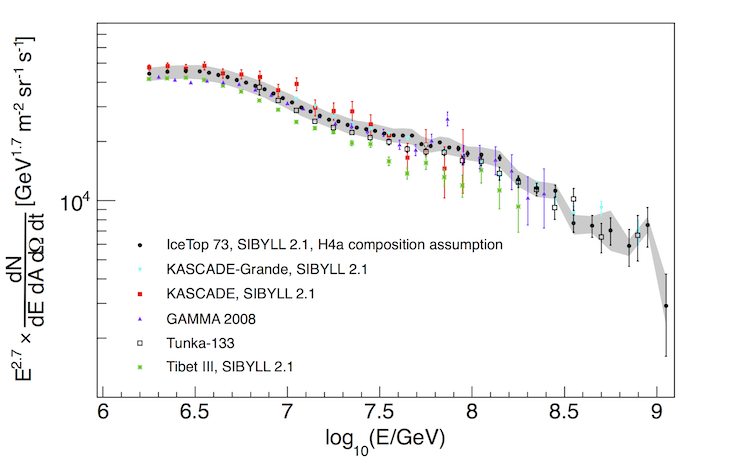Cosmic rays, high-energy particles created in and around extreme cosmic objects, are known to reach energies above 1011 GeV. How and where they are produced, though, have been a science conundrum for several decades now. The more we learn about their energy spectrum and chemical composition, the closer we come to understanding how cosmic rays are accelerated and how they propagate from their original sources. Of particular interest is the energy range above 100 TeV because the transition from galactic to extragalactic cosmic rays is expected to occur in this region.
The IceCube Collaboration publishes today a new measurement of the all-particle cosmic ray energy spectrum in the energy range from 1.6 PeV to 1.3 EeV using data from IceTop, the surface component of the IceCube Neutrino Observatory. The measured spectrum exhibits clear deviations from power law behavior. A spectral hardening is observed around 20 PeV and a steepening around 130 PeV. These results, which confirm with better resolution deviations already reported by several experiments, have just been submitted to Physical Review D.

The figure below compares the IceTop cosmic ray spectrum with several other experiments. The spectrum steepens at the “knee” around 4 PeV, which is generally interpreted as the beginning of the end of the galactic population. Below the knee, cosmic rays are galactic in origin, while above that energy particles from more distant regions in our Universe become more and more likely. The observed deviations from a simple power law spectrum between the knee and the “ankle” (around 4 EeV), now confirmed by the IceCube Collaboration, reflect the transition from galactic to extragalactic populations in ways that remain to be understood. The evolution of the chemical composition of cosmic rays in this region is the next big step required to clarify this transition.

The IceTop shower array consists of 81 stations in its final configuration, covering an area of one square kilometer on the surface above the deep detectors of IceCube. Each station holds two ice Cherenkov tanks, 10 meters apart, with two digital optical modules (DOM) deployed per tank. The array was designed to detect air showers from primary cosmic rays in the 300 TeV to 1 EeV energy range. The analysis presented in this article was performed using data taken from June 2010 to May 2011, when the array consisted of 73 stations only.
Interpretation of the cosmic ray flux in terms of an energy spectrum depends on the mixture of different incoming particles. The observed angular dependence of the data shows that a consistent interpretation requires a mixture of several different groups of nuclei. A mixed composition model, referred to as H4a, which consists of hydrogen, helium, CNO, MgSi and iron has been used to convert the observed shower-size spectrum to a measurement of the all-particle cosmic ray spectrum. Above 100 PeV, the spectrum measurement is observed to be relatively mass independent. The remaining uncertainty due to composition and from other sources is indicated by the shaded band in the first figure.
“The measurement of the IceTop detector shows that, beyond the systematics, the all-particle cosmic ray energy spectrum does not follow a single power law above the knee,” says Bakhtiyar Ruzybayev, an IceCube researcher at the University of Delaware and the corresponding author for this paper. “These measurements provide new constraints that must be satisfied by any models that try to explain the acceleration and propagation of cosmic rays.”
Further cosmic ray spectrum measurements with IceCube
The measurements discussed in this article, which have significantly improved upon previous results of the high-energy cosmic ray spectrum by the IceCube Collaboration, will not be the last ones on this topic. Analyses using coincident events with the full IceCube array as a cosmic-ray detector will be performed in the coming months. Also, with the full IceTop detector, the energy threshold for this analysis can be decreased by an order of magnitude using optimized event selections.
Info “Measurement of the cosmic ray energy spectrum with IceTop-73,” IceCube Collaboration: M.G. Aartsen et al. “Physical Review D88 (2013) 4”, arXiv.org:1307.3795 prd.aps.org